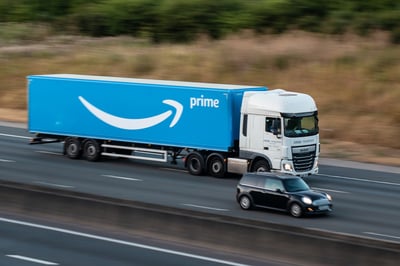
Selling on Amazon often feels mysterious.
Even when you think you did everything right, from sourcing a fantastic product to crafting the perfect copy, it can feel like your listing is the lonely person at the dance. Amazon is a hugely competitive marketplace with other sellers offering products similar to yours.
And since 70% of Amazon customers never click past that first page of search results, you need to refine your listing so that it becomes the belle of the ball. Amazon listing optimization is a set of steps to fine-tune your product listing and help it rank on that critical first page of relevant search results. You can think of Amazon optimization as SEO.
Strong SEO:
A search engine like Google takes the internet’s vast amount of data and resources – videos, articles, images, and the like – and matches them to a specific search term, ranking them from most to least relevant.
Amazon’s A9 algorithm essentially does the same thing, but within the marketplace instead of the entire web. Shoppers use the Amazon search box just like they use Google: they type in a phrase that they believe will get them as close to their desired product as possible.
The keywords in that phrase are critical to your listing’s success. If a potential buyer searches egg cookers on Amazon, A9 will find product listings that include some version of that keyword.
But A9 doesn’t only look at keywords. It wants a detailed description that’s easy to read, high-quality photos to showcase the product, a reliable seller who knows how to keep customers happy, and a satisfying experience when the shipment arrives.
Keep these qualities front-of-mind as you optimize your Amazon listing.
Since it can be overwhelming to figure out how to optimize your Amazon listing, divide the process into these nine easy steps, prioritized by highest impact. Ready to improve your listing and start watching more sales flow in? Let’s get started!
The single most important piece of copy in your listing is your product title. Though a title is just a short string of words, it is deceptively tricky to perfect. A9 loves a straightforward title with easy-to-catch keywords. But shoppers need titles that tell a story about how the product can make their lives easier or better.

Take, for example, the popular Dash Rapid Egg Cooker. With almost 24,000 ratings on Amazon, buyers have lots to say about it. The product title reads, “Dash Rapid Egg Cooker: 6 Egg Capacity Electric Egg Cooker for Hard Boiled Eggs, Poached Eggs, Scrambled Eggs, or Omelets with Auto Shut Off Feature – Aqua.”
Let’s break down the efficacy of this title.
The product brand name, Dash Rapid Egg Cooker, is short but punchy. In four words, you know it’s a lightning-fast way to get breakfast on the table. The title gives you several product features: “6 Egg Capacity,” “Electric Egg Cooker,” “Auto Shut Off Feature,” and “Aqua.”
At the same time, the title offers several ways you can cook your eggs: Hard Boiled, Poached, Scrambled Eggs, Omelets. The product title is to-the-point. The keywords are there, but so is basic syntax. There’s no keyword stuffing, which might look something like this:
“Dash Rapid Egg Cooker, Cooks Eggs Fast Fast Egg Maker Quickly Cooks Omelets Hard Boiled Eggs Poached Eggs Scrambled Eggs Omelets.” A nightmare to read, right? Don’t do that to your customers!
A strong product title balances all these elements:

By including these four ingredients in your product title, you help both the A9 algorithm and your target customers interpret your listing easily.
Because Amazon is such a wide-ranging marketplace, categories and product tags are essential. The platform allows you to include several categories and product tags that vary depending on what you’re selling. In the egg cooker example, you’d want to file the product under appropriate categories such as “Home & Kitchen” and “Small Appliances”. Ensure you’ve properly categorized your product in Product Classifier section of Seller Central.
Classifying your product is one of the simplest but most beneficial steps you can take to help buyers find your listing. As Amazon states, “Amazon uses values provided by sellers to determine where listings appear in the Amazon catalog. If this information is missing or incorrect, customers will have a difficult time finding, comparing, and purchasing your products.”

Once you’ve classified the product, make sure your listing includes every color, size, and version you offer. Say someone really wants a red egg cooker for her red-and-white mod kitchen. If you forget to add the red option to your listing, you’ve lost a sale.
Once you’ve written a compelling and strategic product title, put yourself in your customer’s shoes. After she clicks the title, what does she want to discover?
Because a wall of text is intimidating to customers, use bullet points to make it easy to digest essential information quickly.
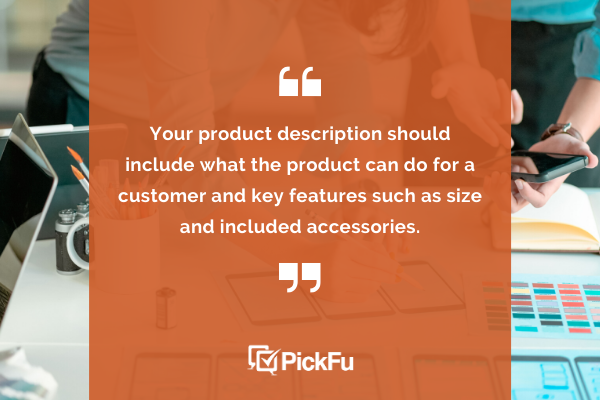
When crafting these bullet points, keep the writing clear, concise, and error-free. Prioritize the most important points.
Once you’ve got the bones of the bullet points down, incorporate keywords. Get an idea of what your competitors are using by running a search for the top trending items in your product’s category. Jot down keywords that apply to your product, too. Then, weave several of these keywords where they fit naturally into your bulleted description.
Your Amazon product photography is one of the most important elements of your listing. Can you imagine buying a product online without first seeing a photo? (Several photos, to be honest). It’s unthinkable. Photos drive perceptions about a product’s quality and value in our lives.
Your imagery must give customers as visceral an experience as possible. Since they can’t pick up your product and examine it closely in person, your photos need to stand in for that encounter.
Use as many photos as you’re allowed. The more images you provide, the more information shoppers have and the easier you make their decision to purchase.
Aim for photos that are emotionally compelling while showcasing the product from every angle. If you’re selling a food product, for example, show the box, the food item, and the packaging, including the nutrition label. For a clothing item, show the garment on a model or several models with different body types.
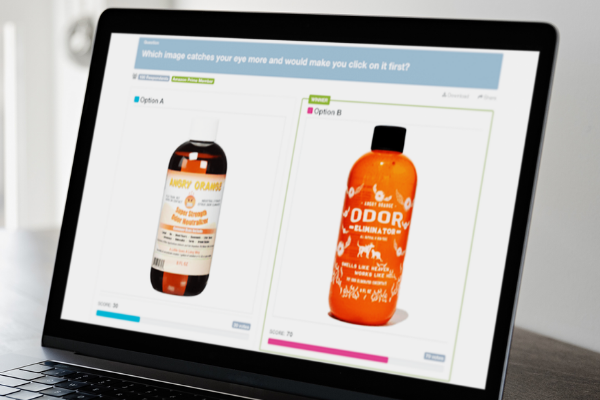
Once you’ve shot and edited your product images, run a split test to find out which one resonates most with your target audience. Or for quicker results, run a poll with respondents in your customer demographic. They’ll vote on their favorite photo and also give you written feedback on why they chose the image they did. Whichever split testing method you choose, feature the winning image as your main product photo.
Sometimes customers will click on the filters on the left-hand side of an Amazon search results page to narrow their search for the perfect item.
Make sure to fill out all the relevant information to the filter fields using e-commerce search filters. That way, when customers check boxes – for an egg cooker under $25, for example – your listing will rise to the top of their search results.
While you can’t directly control how many people click and buy your products, you can work to raise that conversion rate. Find your product conversion rate anytime in Seller Central by clicking on Business Report.
One way to improve your conversion rate is to join the Amazon FBA (Fulfilled by Amazon) program. Becoming a Prime Seller consistently puts your product in front of Prime members, who tend to convert at a rate of 74%. Non-Prime members convert at a rate of about 13%. That’s a huge difference!
If you don’t want to pay more for FBA, try offering perks like free shipping, extra-competitive pricing, and coupons. These incentives will all make customers more likely to purchase your product over your competitors’.
The more people who see your product, the better, so share your listing with your networks across social media. You can also experiment with deep-discount and chatbot campaigns to goose your conversion numbers, but be careful not to violate Amazon’s Terms of Service.
Sponsored products are a type of Amazon pay-per-click ad that appear among the results in any search. They look just like any other organic listing except for a gray “Sponsored” label. Basically, you’re paying Amazon to push your ad to the top of relevant search results.
Sponsored products also appear in every nook and cranny of a buyer’s shopping journey, which means they’re highly visible – and clickable.
To create a Sponsored Products Ad, head to Campaign Manager in Seller Central and set the name, duration, and budget for the campaign. You can then decide whether you want Amazon to automatically target likely customers for you, or if you want to manually target them yourself. Manually targeting your audience means you provide your own keywords.
You might hear the phrase “winning the Buy Box” when it comes to sponsored products. The Buy Box is the section of the product detail page that includes the Add to Cart or Set up recurring delivery buttons.
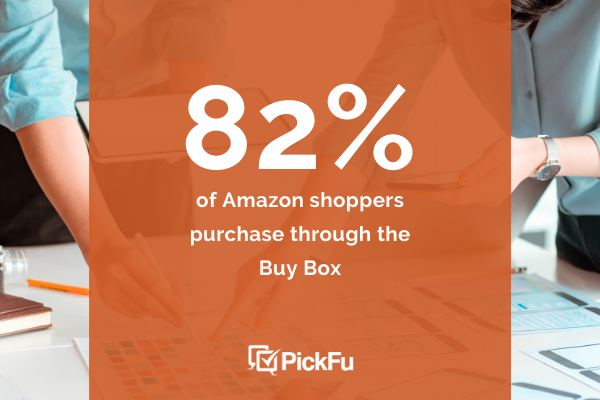
Eighty-two percent of Amazon shoppers purchase through the Buy Box, so being featured here is competitive.
To increase your chance of winning the Buy Box, make sure you:
Product reviews can be notoriously difficult to get, but they give you so much credibility with potential buyers, especially when the reviews come from verified purchases, skew positive, and contain relevant information.
Most customers don’t ever leave reviews unless they’re upset with you or your product. So what do you, the seller, do to increase the number of reviews your listing has?
There are many things you can’t do to increase your reviews, such as writing reviews yourself, offering free products in exchange for reviews, or swapping good reviews with other brands. Make sure you know Amazon’s rules by heart.
Here’s what you can do:
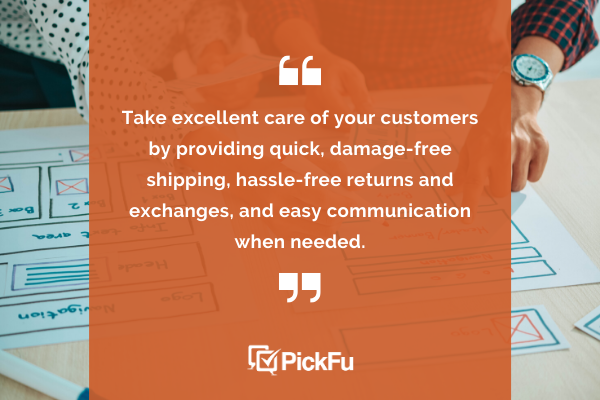
Gain your customers’ trust by answering any questions that they have. These questions are published for future buyers to read during their buying journey – and many do. Customers often ask random but important-to-them questions, like “Does this come with batteries?” or “Would this fit in a mid-sized motorhome?”
When you answer questions with clean grammar, professionalism, and politeness, and sign off as the seller of your product, you make an impact on your audience. Plus, you’ll make it that much easier for them to convert because you’ll add to their understanding of your product.
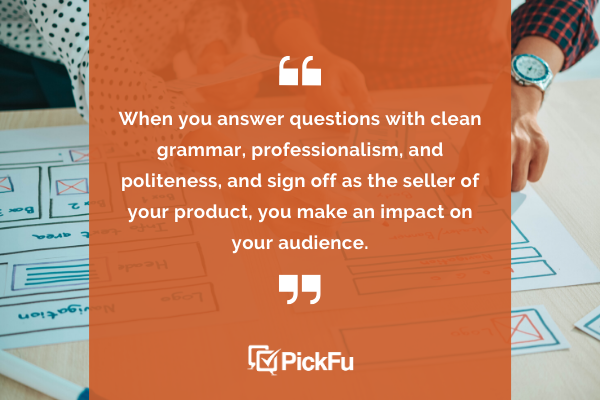
When it comes down to it, you have more control over your listing performance than you might have thought. And that’s a good thing! By following these simple but critical steps, you’ll put yourself above the competition and ensure that your product listing gets noticed.
If you haven’t optimized your Amazon listing yet, there’s no better time to begin. It’ll take dedicated work, but the payoff will endure.
Need more help with your Amazon listing? Learn how to sell on Amazon to ensure maximum profit from your efforts!
Kim Kohatsu is the CMO at PickFu, a software company that helps businesses know what sells before they sell it. Kim’s marketing team guides entrepreneurs in using PickFu to write better copy, present products in their best light, and position themselves as market leaders.
From speedy shipping to subscribe and save, Amazon is all about convenience.
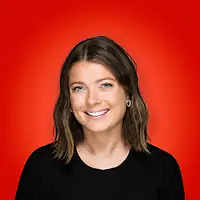 by Deirdre O'Donoghue
by Deirdre O'Donoghue
More than 140,000 third-party sellers made more than $100,000 in yearly sales this year.
 by Deirdre O'Donoghue
by Deirdre O'Donoghue
Amazon sells over 12 million products.
 by Deirdre O'Donoghue
by Deirdre O'Donoghue
From speedy shipping to subscribe and save, Amazon is all about convenience.
 by Deirdre O'Donoghue
by Deirdre O'Donoghue
More than 140,000 third-party sellers made more than $100,000 in yearly sales this year.
 by Deirdre O'Donoghue
by Deirdre O'Donoghue
